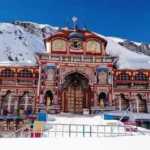Imagine standing on the shores of the Arabian Sea, the salty breeze carrying echoes of ancient chants, and waves lapping against a city that, as legend says, once submerged beneath the ocean. This isn’t a fantasy. This is Dwarka — one of India’s oldest and most spiritually significant cities.
Dwarka is often called the ‘City of Lord Krishna,’ but the city offers far more than temples and rituals. It is a place filled with legends, ancient ruins, deep devotion, and a sense of mystery that is hard to overlook—even the stories of underwater ruins add to its intrigue.
Dwarka in Hindu Mythology: The Capital of Krishna’s Kingdom
In Hindu mythology, Dwarka stands as a city not built by mortals but by divine will—a golden kingdom that rose from the sea at the command of Lord Krishna, the eighth avatar of Vishnu. Known as Dvaraka, meaning “Gateway to Heaven,” it symbolizes divine order, royal splendor, and spiritual liberation. It forms a key node in India’s Char Dham Yatra, alongside Rameswaram, Badrinath, and Puri.
The Birth of a Divine City
After slaying the tyrant Kamsa in Mathura, Krishna became a political and spiritual leader of the Yadava clan. However, Mathura came under constant threat from Jarasandha, the powerful king of Magadha and Kamsa’s father-in-law. To protect his people, Krishna chose diplomacy over destruction. He decided to relocate the Yadavas far from conflict.
According to the Harivamsa and Mahabharata, Krishna prayed to Vishwakarma, the divine architect, to build a city in the ocean. With the blessings of Samudra Deva (the Sea God), who granted land from the seabed, Vishwakarma constructed Dwarka—a fortified, golden city with palaces, gardens, lakes, and wide streets. It had 900,000 royal palaces, adorned with gems and precious stones, where Krishna ruled as the king.
Dwarka: The City of Dharma and Order
Unlike typical kingdoms that pursued conquest and wealth, the people of Dwarka built their city on Dharma (righteousness) and Krishna’s divine vision. It became a sacred space where Krishna lived his household life with his eight principal queens (Ashtabharya), governed wisely, and guided humanity in times of spiritual and moral crisis.
Legends describe Dwarka as a bustling city with markets, temples, assembly halls, and gates facing all directions. Its prosperity rivaled even Indra’s heaven. Krishna’s presence made it a pilgrimage site even during his lifetime.
The Submergence of Dwarka
One of the most dramatic and mystical aspects of Dwarka’s mythology is its disappearance into the sea. After the Kurukshetra war and the demise of the Yadava clan in a fratricidal conflict (as foretold by Gandhari’s curse), Krishna completed his earthly mission. As he departed the mortal world, the ocean swallowed Dwarka, returning it to the depths from where it came.
The Mausala Parva of the Mahabharata vividly describes this event:
“The sea, with roaring waves, came and engulfed the entire city of Dwaraka, leaving behind no trace of its former glory.”
This submergence is not merely symbolic—it represents the cyclical nature of time in Hindu cosmology, where even the most divine cities are not eternal in the material world.
Spiritual Legacy
Even after its fall, Dwarka lived on in memory, prayer, and pilgrimage. Scriptures declare it one of the Sapta Puri—the seven sacred cities that grant Moksha (liberation). Krishna’s association with Dwarka turned it into a sacred dham, and today’s Dwarkadhish Temple stands as a testament to that timeless devotion.
For devotees, Dwarka is not just a lost city; it is Krishna’s eternal abode, a place where Bhakti (devotion) flows like the ocean itself, washing away worldly attachments.
The Historical Journey of Dwarka
Dwarka, a sacred coastal city in Gujarat, holds a unique place in Indian history—where mythology and archaeology meet, and ancient seafaring civilization comes alive. While Hindu tradition identifies it as the legendary city founded by Lord Krishna, historians have examined its story through epigraphic records, archaeological evidence, and classical literature.
Classical References and Early Mentions
The Mahabharata and Harivamsa give us the earliest textual reference to Dwarka, describing it as Dvaravati—a well-fortified, prosperous city that Lord Krishna built on the shores of the western sea after migrating from Mathura. Though these texts are epic in nature, later historical documents provide stronger context.
Greek writers like Arrian and Ptolemy referred to the western coast of India and its trading ports, possibly alluding to ancient Dwaraka. The city also finds mention in the Periplus of the Erythraean Sea (1st century CE), suggesting its relevance in maritime trade networks that connected India with the Roman world.
Archaeological Evidence: Underwater Discoveries
The turning point in Dwarka’s historical inquiry came with the underwater archaeological explorations conducted by the Marine Archaeology Unit (MAU) of the National Institute of Oceanography (NIO) and the Archaeological Survey of India (ASI).
Between 1983 and 2002, marine archaeologists led by Dr. S. R. Rao, a pioneering Indian archaeologist, discovered submerged structural remains in the Arabian Sea near present-day Dwarka. These included:
- Stone blocks with dovetail joints
- Remains of a fortified wall
- Anchors and pottery dated to 1500 BCE – 1400 BCE
Radiocarbon dating and thermoluminescence analysis of artifacts suggested an urban settlement that may have thrived during the Late Harappan period. These findings align chronologically with the decline of the Indus Valley Civilization and lend historical weight to the possibility that Dwarka, or a proto-Dwarka, existed as a trading hub in antiquity.
Religious and Cultural Continuity
Historical records show that Dwarka remained a significant pilgrimage center throughout the centuries. Inscriptions found in the Dwarkadhish Temple and other regional temples point to generous donations by Gujarat’s Solanki and Chavda dynasties, especially between the 9th and 12th centuries CE. Vajranabh, Lord Krishna’s grandson, first rebuilt the temple, and centuries later, Adi Shankaracharya helped revive it while reestablishing Hindu pilgrimage routes in the 8th century CE.
Arab geographers and travelers like Al-Biruni also mention temples on the Gujarat coast, emphasizing Dwarka’s religious and cultural stature in medieval India.
Dwarka Under Muslim Rule and Colonial Influence
During the medieval period, Dwarka witnessed occasional invasions. In the 15th century, the city and its temples suffered damage at the hands of Mahmud Begada, the Sultan of Gujarat. Local rulers and devoted pilgrims restored the temples over time, highlighting the city’s resilience and enduring sanctity.
During the British era, Dwarka retained its spiritual importance while also serving as a fishing and trading town. British surveys noted the temple’s grandeur and documented local legends, further contributing to the knowledge base about Dwarka.
Dwarka Today: A Confluence of Myth and History
Today’s Dwarka is recognized as one of the Char Dham pilgrimage sites, where devotees and scholars alike come to experience its dual heritage—mythical and historical. The ASI has declared Dwarka a site of national importance, and research continues to uncover its layered past.
For historians, Dwarka represents more than just a religious site—it is a microcosm of Indian civilization: maritime legacy, urban planning, religious continuity, and resilience.
Geographical Location:
The Dwarkadhish Temple stands with grandeur on the western edge of India, in the city of Dwarka, located in Devbhumi Dwarka district of Gujarat. It lies along the Arabian Sea, where the Gomti River meets the ocean, giving the temple an almost divine coastal setting. Devotees honor this sacred town as the ‘Gateway to Moksha’ and count it among the revered Char Dham pilgrimage sites.
Dwarka is well connected by road, rail, and air. The nearest airport is Jamnagar, around 130 km away, while Dwarka Railway Station connects it to major cities like Ahmedabad, Rajkot, and Mumbai. The city sits on National Highway 51, making it accessible by private vehicles and buses from all parts of Gujarat.
Positioned at a latitude of 22.24°N and longitude of 68.97°E, the temple enjoys a dry coastal climate. The temple’s towering shikhara rises high above the city, and fishing boats in the Arabian Sea often spot it from miles away, using it as a navigational landmark. The conch flag fluttering at the top marks not just devotion, but also direction.
Believers hold that Lord Krishna ruled his kingdom on this sacred land—wrapped in myth and history—where geography, divinity, and legend come together.
The Dwarkadhish Temple: Jewel of Gujarat
No visit to Dwarka is complete without witnessing the grandeur of the Dwarkadhish Temple, also known as Jagat Mandir. Krishna’s great-grandson Vajranabha built the original temple over 2,000 years ago, and later rulers reconstructed the current structure in the 15th–16th century.
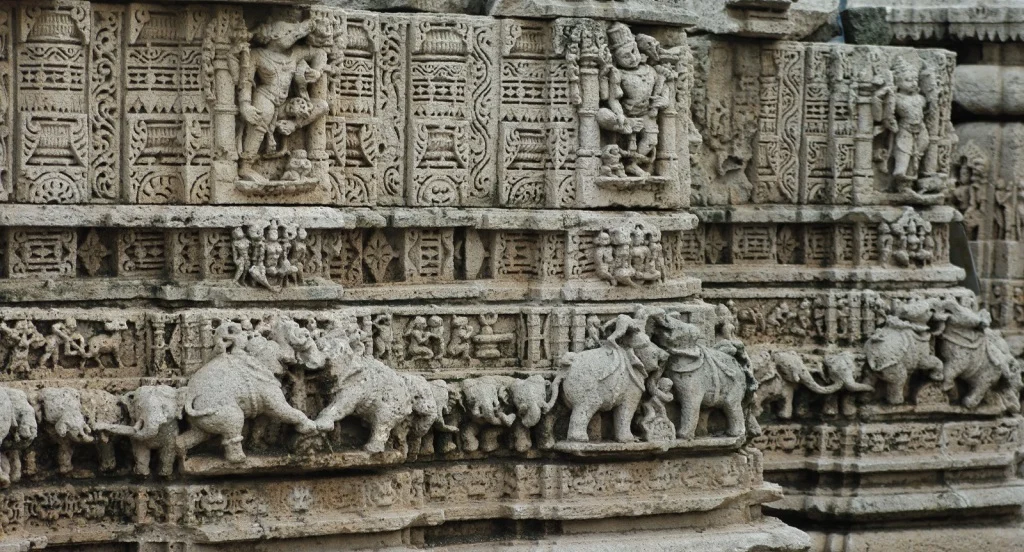
Key Features:
- Architecture: The Dwarkadhish Temple, also known as Jagat Mandir, is an outstanding specimen of Chaulukya style architecture—a blend of sculptural grandeur and spiritual symbolism. Rising to a height of about 78 meters, the temple stands proudly on the banks of the Gomti River, facing the roaring Arabian Sea. Its 72-pillared sanctum and intricately carved spire (shikhara) reflect the mastery of 15th–16th century artisans.
- Iconic Flag Ritual: The temple flag, changed five times a day, is considered a symbol of Krishna’s enduring presence.
- Garbhagriha (Sanctum): Houses the black idol of Dwarkadhish (Krishna) in a majestic form.
The temple draws millions annually and is part of the Char Dham Yatra, making it a central pillar in Hindu pilgrimage.
My Experience at the Temple
Stepping into the temple premises for the first time, I felt an overwhelming mix of awe and surrender. The sheer height of the shikhara against the deep blue sky made me pause and take a deep breath. As I climbed the age-old stone steps, the rhythmic chanting of mantras and the fragrance of incense transported me to another realm.
Inside the sanctum, as I gazed into the serene eyes of Dwarkadhish Krishna, I felt a profound stillness. It was as if time stood still. The walls seemed alive with energy—holding within them centuries of prayers, tears, and faith. I touched the cool stone pillars, imagining the hands of countless devotees who had stood there before me.
What struck me most was the flag-changing ceremony, which I witnessed from my guesthouse rooftop earlier in the morning. Seeing the priest swiftly climb the spire with unwavering faith to hoist the massive flag was nothing short of divine choreography.
This wasn’t just a visit—it was an experience that etched itself into my soul.
How to Reach Dwarkadhish Temple
Reaching Dwarkadhish Temple is a spiritual journey in itself, with several travel options depending on your starting point. Dwarka, Gujarat, hosts the temple and connects it well to major cities by air, train, and road.
By Air:
The nearest airport is Jamnagar Airport, around 130 km from Dwarka. From the airport, you can hire a cab or take a state-run bus to reach the temple city in about 2.5 to 3 hours.
By Train:
Dwarka has its own railway station, Dwarka Railway Station, which is part of the Western Railway zone. Trains to Dwarka are available from major Indian cities such as Ahmedabad, Rajkot, Vadodara, Surat, Mumbai, and even Delhi.
By Road:
Dwarka is connected by a network of state and national highways. It lies along National Highway 51. Buses (both private and GSRTC) and taxis are available from all nearby towns and cities.
Where to Stay Near Dwarkadhish Temple
Dwarka offers a wide range of stay options catering to all kinds of travelers—whether you’re a solo pilgrim, visiting with family, or part of a group tour. From simple dharamshalas to luxurious hotels, the holy city ensures a comfortable stay for everyone.
Budget & Mid-Range Options:
Bharat Sevashram Sangha and Hotel Kailash offer affordable rooms with basic amenities for pilgrims.
Hotels like Guruprerna Beacon Resort, Hotel Damji, and Hotel Shree Darshan are popular among mid-budget travelers. These are located very close to the temple and the sea, offering both convenience and spiritual ambiance.
Luxury Options:
The Fern Sattva Resort, Dwarkadhish Lords Eco Inn, and VITS Devbhumi provide premium comfort with modern amenities, fine dining, and serene views of the coast.
Many of these hotels also assist with temple darshan timings and local sightseeing.
Dwarka vs Other Krishna Cities: What Makes It Unique?
| Feature | Dwarka | Mathura | Vrindavan | Puri |
| Role in Krishna’s Life | Capital City | Birthplace | Childhood Home | Linked through Jagannath Temple |
| Temple Significance | Dwarkadhish Mandir | Shri Krishna Janmabhoomi | Banke Bihari Temple | Jagannath Temple |
| Coastal City | Yes | No | No | Yes |
| Marine Archeology | Active | Minimal | None | No |
The Stillness of Sudama Setu
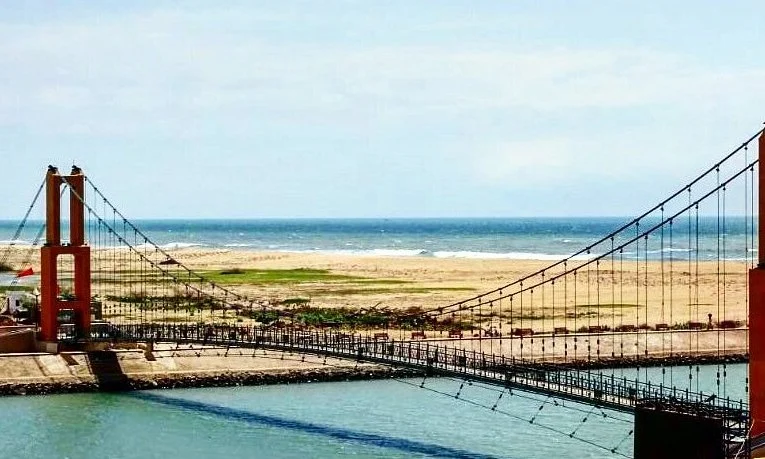
Sudama Setu is a pedestrian suspension bridge over Gomti river in Dwarka, Gujarat, India. It takes its name from Sudama, the childhood friend of Krishna. Authorities proposed the bridge in 2005 and opened it in 2016.
It connects the Jagat Mandir in mainland Dwarka with Panchnad, also known as Panchkui Tirth, on the island to its southeast.
Things to Do in and Around Dwarka
1. Visit Beyt Dwarka
Located about 30 km from Dwarka and accessible via a short boat ride from Okha Port, Beyt Dwarka is a small island with immense mythological and spiritual significance. According to Hindu belief, this was the original residence of Lord Krishna, where he lived with his family and received guests, including Sudama, his childhood friend.

The name “Beyt” means island, and true to its name, Beyt Dwarka is surrounded by the Arabian Sea’s turquoise waters. The main temple, believed to have been established by Guru Vallabhacharya, houses idols said to be consecrated by Krishna’s grandson Vajranabh.
Apart from its religious importance, the island also features ancient ruins, conch-strewn beaches, and marine life, making it a peaceful and spiritually enriching day trip from the mainland Dwarka.
2. Rukmini Devi Temple: The Forgotten Queen’s Shrine
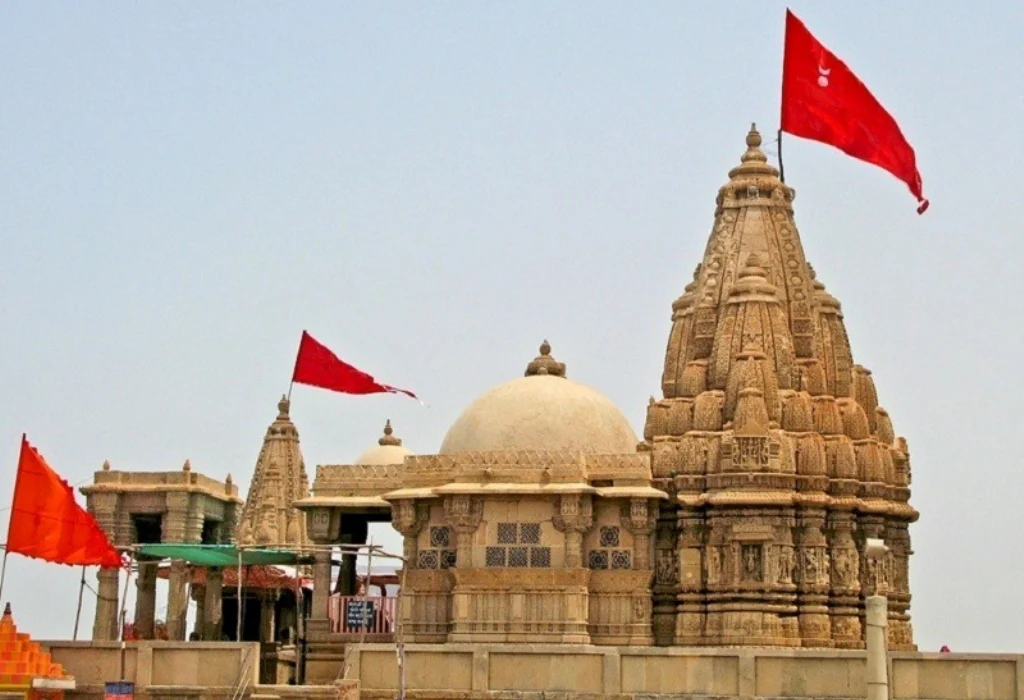
Located about 2 km from the main Dwarkadhish Temple, the Rukmini Devi Temple is dedicated to Rukmini, the chief consort of Lord Krishna. Though small and often less crowded than the main temple, it holds deep spiritual and cultural importance.
According to legend, Rukmini was separated from Krishna due to a sage Durvasa’s curse. As a result, her shrine stands away from Dwarka’s main temple complex. This geographical distance reflects their symbolic separation and adds a mystical charm to the site.
Built in the 12th century, the temple showcases exquisite Nagara-style architecture, with intricate carvings of gods, goddesses, and celestial beings adorning its sandstone walls. The sanctum houses a beautiful idol of Goddess Rukmini with four arms holding Shankha, Chakra, Gada, and Padma—symbols of divine strength and grace.
A unique tradition here is the offering of water to Rukmini Devi, believed to quench the thirst she suffered due to the sage Durvasa’s curse.
3. Marine National Park
Located in the Gulf of Kutch, about 100 km from Dwarka, the Marine National Park in Jamnagar district is India’s first marine sanctuary, offering a rare glimpse into the vibrant and delicate ecosystem beneath the Arabian Sea.
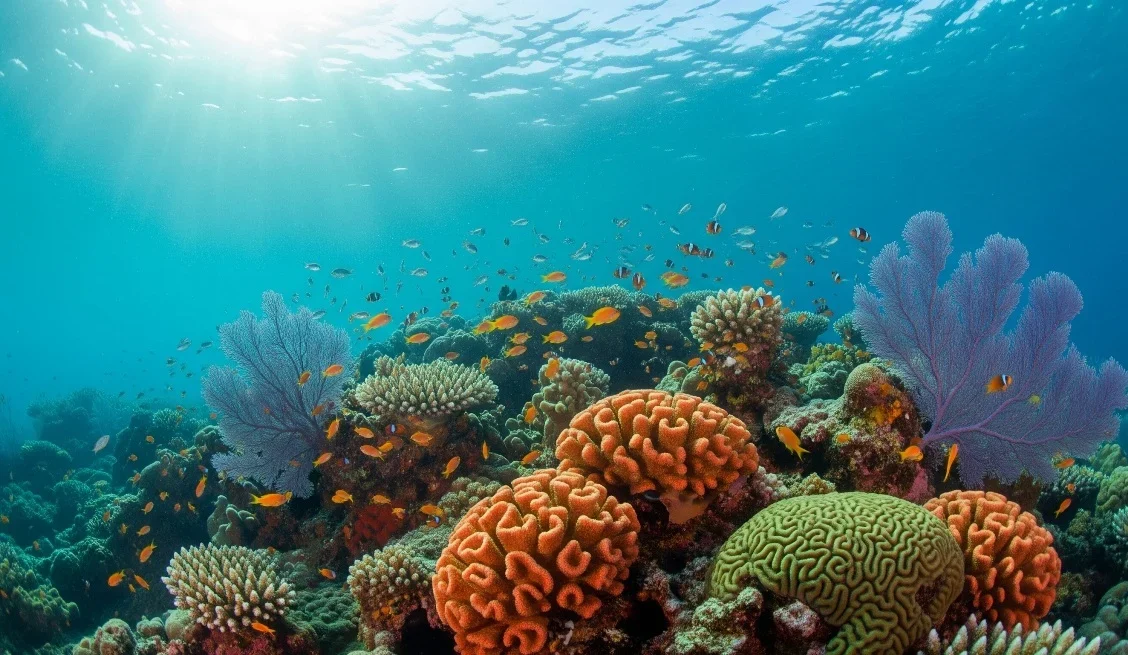
Established in 1982, this protected area spans over 458 sq km and includes 42 islands, the most accessible being Pirotan Island. Unlike typical wildlife sanctuaries, this park is best explored during low tide, when coral reefs, marine life, and intertidal zones emerge into view.
Home to corals, sponges, jellyfish, octopuses, dolphins, turtles, starfish, sea cucumbers, and even dugongs, the park is a haven for marine biologists and eco-tourists. Migratory birds like flamingos, pelicans, and herons also flock here in winter, turning the seascape into a living postcard.
4. Gomti Ghat: Sacred Serenity at Dwarka

Gomti Ghat, located just beside the revered Dwarkadhish Temple, is where the sacred Gomti River meets the Arabian Sea. Considered one of the most divine ghats in India, this spot is believed to cleanse sins and bless devotees with spiritual merit. The ghat is lined with ancient stone steps, small shrines, and bustling priests offering rituals. Legends say that Gomti is the daughter of Sage Vashishta and emerged here by the wish of Lord Krishna himself.
When I visited Gomti Ghat, the experience was both calming and powerful. The sound of conches, the aroma of incense, and the gentle flow of the river created an otherworldly atmosphere. I dipped my feet in the holy waters and felt a strange stillness wash over me. A local priest approached with a diya and offered to perform a small puja.
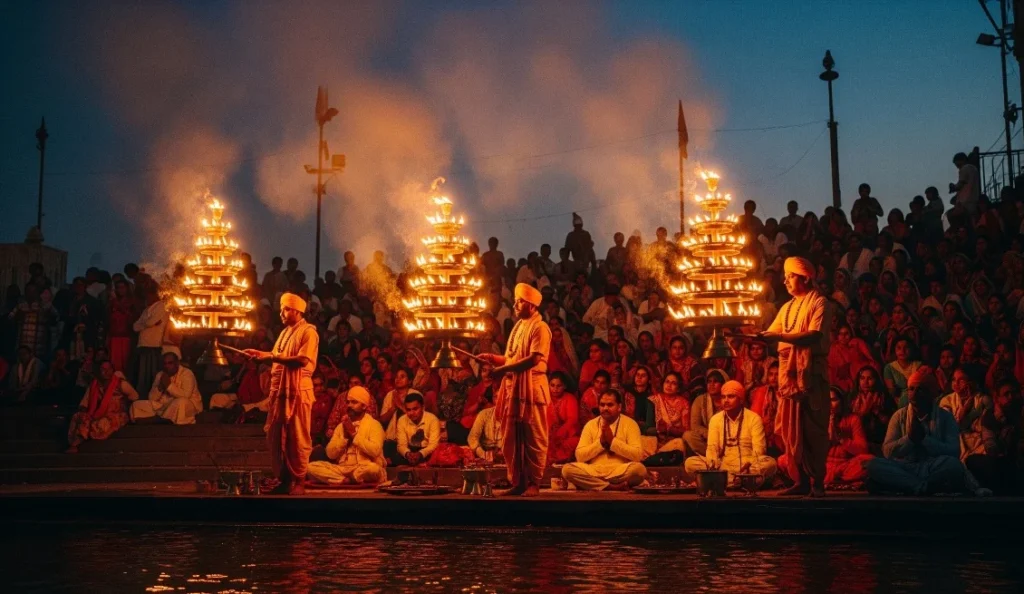
As the sun dipped behind the Dwarkadhish Temple, I joined the evening aarti by the ghat—it was magical. Surrounded by chants, flames, and faith, I felt deeply connected—not just to the place, but to something beyond words.
5. Local Crafts and Cuisine
Dwarka is not just a spiritual destination—it’s also a place where tradition lives on through art, craft, and food. As I walked through the narrow lanes near the temple and the bustling local markets, I discovered a world rich in color and flavor.
Local Crafts:
The markets are dotted with stalls selling bandhani fabrics, intricate shell and mirror work, handcrafted brass items, and wooden toys. The artisans here continue age-old techniques, many passed down for generations. I picked up a small idol of Lord Krishna, carved from softwood and painted by hand—it now sits on my desk as a memory of that soulful trip. The shops near Sudama Setu bridge and Gomti Ghat also had beautiful conch shells etched with Hindu symbols, perfect as souvenirs or gifts.
Local Cuisine:
Gujarat’s vegetarian fare truly won my heart. I tasted the delicious Kathiyawadi thali—loaded with rotla, ringna no olo (smoky mashed brinjal), sev tameta nu shaak, khichdi, and a dollop of white butter. The sweet-and-savory balance in every bite felt like home-cooked food from a grandmother’s kitchen. I still remember sipping chaas (buttermilk) at a roadside eatery near the Dwarkadhish temple—it was refreshingly simple after the morning darshan. And if you’re a fan of sweets, don’t miss the mohanthal and doodhpak served at local sweet shops.
Best Time to Visit
- October to March: Pleasant climate and ideal for sightseeing.
- Avoid May-July: Summer heat and monsoons may disrupt travel plans.
Activities: Bird watching, snorkeling (in select areas), boat rides, and tidepool walks.
Permission is required from the Forest Department (especially for Pirotan Island).
Tip: Book during non-peak hours or shoulder seasons to avoid long temple queues.
Dwarka’s Relevance in Modern India
In 2021, the Government of India announced plans for a Maritime Heritage Complex in Dwarka. This project is not just a regular tourist attraction—it is designed to highlight India’s rich naval history and the fascinating blend of legend and reality associated with it. In many ways, it reflects an effort to preserve ancient stories and present them with pride on a global stage.
At the same time, spiritual tourism is gaining remarkable momentum. Dwarka has emerged as a destination that appeals not only for its temples and sacred atmosphere, but also for its deep historical significance and natural beauty. It is, in essence, three unique experiences combined into one.
Conclusion: Dwarka is More Than a Destination
Visiting Dwarka is a truly unique experience. You may arrive thinking you can separate legend from history, but this city blurs those lines in the most fascinating way. The ancient stories feel alive here—as if you might stumble upon a trace of Krishna himself.
People come to Dwarka for many reasons—seeking the presence of old gods, uncovering hidden stories, or simply finding peace within. Whatever the purpose, the city embraces it all—myth, mystery, and personal longing. And the sky over Dwarka? It is as vast and welcoming as the city itself
May your journey to Dwarka open doors to ancient wonders and inner peace.
FAQs:
Dwarka, a sacred location, is associated with Lord Krishna. This city is a prominent pilgrimage destination that draws devotees from all over the world.
All visitors are welcome, regardless of religion. The temple is open to everyone.
The temple typically opens daily from 6:30 AM to 1:00 PM, then reopens from 5:00 PM to 9:30 PM.
Entry is free for general darshan. Special darshan passes cost around ₹200, and VIP darshan is ₹500. Seva charges range from ₹51 to ₹5,000 based on rituals.
Key celebrations include Janmashtami, marking Lord Krishna’s birth, followed by Holi, Rukmini Vivah, Basant Panchami, Ram Navami, Akshay Tritiya, Diwali, and Sharad Purnima.
The Dwarkadhish idol’s closed eyes are often interpreted as a symbol of love, divine grace, and the Lord’s meditative state.
Yes, underwater explorations near Dwarka have uncovered structures and artifacts suggesting the existence of an ancient, submerged city.
The temple does not allow the mobile phones/ cameras into the temple complex.
The cost for scuba diving in Dwarka, including Shivrajpur, typically starts at Rs.2,400 per person. This price includes all necessary equipment, a dive master, and often includes photos and videos of the dive.


